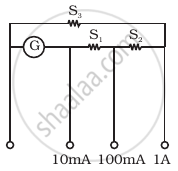Advertisements
Advertisements
प्रश्न
A galvanometer shows full-scale deflection for current Ig. A resistance R1 is required to convert it into a voltmeter of range (0 - V) and a resistance R2 to convert it into a voltmeter of range (0 - 2V). Find the resistance of the galvanometer.
उत्तर

In the first case the potential difference between A and B,
`V = I_gR_1 + I_gG`
`I_g = V/(R_1 + G)`
Where G = Resistance of galvanometer
∴ `R_1 + G = V/I_g`
`R_1 = V/(Ig) - G`
⇒ G = `V/(Ig) - R_1`
In the second case,
`I_g = V/(R_2 + G)`
R2 is the Resistance required to change the range from 0 - 2V.
`I_g = (2V)/(R_2 + G)`
`R_2 + G = (2V)/I_g`
`R_2 = (2V)/I_g - G`
⇒ R = `(2V)/I_g - R_2`
Hence, the resistance of the galvanometer is respectively `V/(Ig) - R_1` and `(2V)/(Ig) - R_2`.
APPEARS IN
संबंधित प्रश्न
Define the current sensitivity of a galvanometer ?
Explain, giving reasons, the basic difference in converting a galvanometer into (i) a voltmeter and (ii) an ammeter?
State how a moving coil galvanometer can be converted into an ammeter.
A galvanometer coil has a resistance of 12 Ω and the metre shows full scale deflection for a current of 3 mA. How will you convert the metre into a voltmeter of range 0 to 18 V?
The current sensitivity of a galvanometer is defined as ______.
In a moving coil galvanometer the deflection (Φ) on the scale by a pointer attached to the spring is ______.
A moving coil galvanometer can be converted into an ammeter by ______.
A multirange current meter can be constructed by using a galvanometer circuit as shown in figure. We want a current meter that can measure 10 mA, 100 mA and 1A using a galvanometer of resistance 10 Ω and that prduces maximum deflection for current of 1mA. Find S1, S2 and S3 that have to be used

A resistance of 3Ω is connected in parallel to a galvanometer of resistance 297Ω. Find the fraction of current passing through the galvanometer.
Assertion: When an electric current is passed through a moving coil galvanometer, its coil gets deflected.
Reason: A circular coil produces a uniform magnetic field around itself when an electric current is passed through it.
